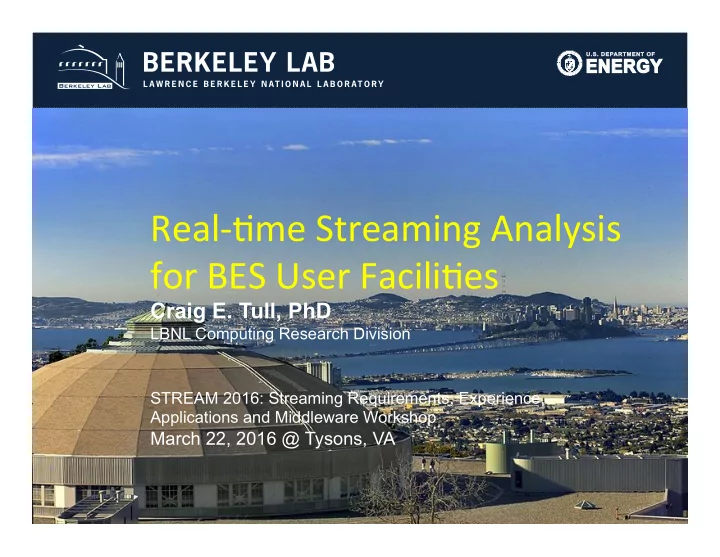

Real-&me Streaming Analysis for BES User Facili&es Craig E. Tull, PhD LBNL Computing Research Division STREAM 2016: Streaming Requirements, Experience, Applications and Middleware Workshop March 22, 2016 @ Tysons, VA
BES Facilities serve 16,000 users/yr in Materials, Biology, Energy, Medicine, … • Virtually every area of science and technology are taking advantage of Lightsources, etc. • The ALS user base is expanding to new areas and includes more 1 st timers who cannot afford long investment in learning hardware & software. • Data volumes are exploding: – Lightsources are getting brighter – Detectors are getting faster – Beamlines are automating • New mathematical techniques, new architectures, and even new paradigms (eg. Neuromophic, Quantum) are being developed or researched. CETull@lbl.gov - 22 March 2016
SPOT Suite: Integration of ALS, ESnet, and NERSC into a proto-super-facility. • Computing Research Div., Advanced Light Source, Material Science Div., ESnet, NERSC • Real-time processing needed for: Time-resolved, in-situ experiments & Data Quality Assurance CETull@lbl.gov - 22 March 2016
Daya Bay “Real-Time” Processing CETull@lbl.gov - 22 March 2016
Remote experiments now a reality. 25mar2014: UK scientists conduct remote experiment using new BL 7.3.3 robot and SPOT. Able to assess experimental data on train to Zurich via mobile interface. From: Alessandro Sepe as2237@cam.ac.uk -- Actually, I did not feel any difference between a standard beam7me and this NERSC remotely CETull@lbl.gov - 22 March 2016 accessed beam7me, which is quite an extraordinary result.
“SPOT was like an extra pair of hands working in the background.” – N.Sauter Jun’14 3/22/16 CETull@lbl.gov - 22 March 2016
Real-time access to ASCR HPC changes the way scientists imagine the facility. • "I've been having more users bring up the idea of running experiments with a 'digital twin'. Take an initial data set, send to HPC, create a 3d model of their sampleas input to simulation, which they start right away and run as they run experiments at the beamline. Matching up and comparing the results of the simulation with the results of the experiment.” • 1. Simulating flow and reactions underground at the pore scale: Jonathan Ajo-Franklin (ESD, LBNL) David Trebotich (CRD, LBNL): http://ascr- discovery.science.doe.gov/2014/09/pore-samples/ • 2. Simulating material failure in realistic conditions Rob Ritchie (MSD, LBNL), Michael Czabaj (UofU) http://newscenter.lbl.gov/2012/12/10/space- age-ceramics-get-their-toughest-test/ • 3. Simulating heat shield ablation Nagi Mansour, NASA http://www.nas.nasa.gov/publications/articles/feature_TPS_panerai.html CETull@lbl.gov - 22 March 2016
GISAXS Super-Facility Demo Data Flow On-the-fly Real-time calibration, access via web portal Transfer to NERSC processing Combining: GIXSGUI, dpdak + … Data collection Analysis and modeling on NERSC supercomputers: HipGISAXS simulation HipRMC fitting start with random system move par&cle random FFT Compare CETull@lbl.gov - 22 March 2016 Autotuning
SPADE used for production orchestration of network data movement • SPADE developed in IceCube, used in Daya Bay & ALS • Underlying protocols: scp, bbcp, gridftp, Globus Online, RDMA? • Highly Configurable: push, pull, relay, local • Integrated warehouse, catalog, monitoring; Highly instrumented CETull@lbl.gov - 22 March 2016 9
X-SWAP: Time-sensitive processing on a Queue-based facility (NERSC) • Tomography workflow on NERSC = DAG with 48 graph nodes • NERSC batch queue wait time penalty was significant. • Implemented RabbitMQ worker node model (summer 2015) – Queue penalty dropped by 50% or more – Can be optimized by deploying more workers – Provides additional robustness for machine failures (1500 jobs automatically resumed after 1-day NERSC outage) – Adopted this same technique to Daya Bay CETull@lbl.gov - 22 March 2016
X-SWAP: Instrumented NERSC workflow provides lever for optimizing throughput. • ALS beamline 8.3.2 (Tomography) queue wait time dropped from 60-70% to 30% of total turn-around time for jobs. • We can see we will gain (<20%) by deploying more workers. Implementation of SPOT task queue using RabbitMQ (BL8.3.2) CETull@lbl.gov - 22 March 2016
Experiments’ and Facilities’ realtime streaming requirements vary. • Overnight (eg. telescopes, day shift experiments) – Plan campaign for next shift/day • Hourly (eg. stable, long-term HEP experiments) – Detect problems; Maintain steady-state data taking • Minutes (eg. time-resolved, in-situ experiments) – Follow experiment evolution; Verify data quality • “Instantaneous” - like a "software" microscope • BES Experiments are “new” every day • Understanding, instrumenting, and modeling the scientific workflow are powerful tools in assessing trade-offs between speed and quality of streaming data analysis. CETull@lbl.gov - 22 March 2016
In a complex workflow, not all paths are of equal value for streaming feedback. CETull@lbl.gov - 22 March 2016
X-SWAP: Instrumenting and modeling to minimize workflow branch latency. • SPOT Tomographic processing is a DAG of 54 graph nodes. • Fast feedback on a small subset of data is sufficient for QA. • Introduce a new DAG branch (Fast TomoPy) • First feedback reduced from ~16 minutes to ~2 • Trade-off quality & completeness. CETull@lbl.gov - 22 March 2016
Summary • Real-time processing important for QA, in-situ time-resolved experiments, and for experimental steering. • The meaning of “real-time” varies with scientific goals. • Optimizing overall throughput important. But, analysis of workflows yield opportunities to trade off fast user feedback with quality/completeness of results. • Pairing real-time simulations with real-time analysis increasingly needed to maximize scientific insight. • X-SWAP: Complex, distributed workflows need instrumentation and modeling to understand and optimize. • DEDUCE: Need to inject decision-making into data workflows. CETull@lbl.gov - 22 March 2016
Recommend
More recommend